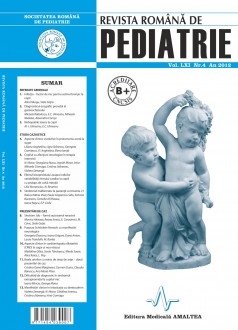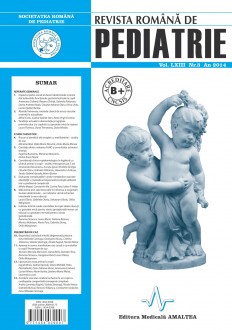SELECT ISSUE

Indexed

| |

|
|
|
| |
|
|
|

|
|
|
|
|
|
|
HIGHLIGHTS
National Awards “Science and Research”
NEW! RJP has announced the annually National Award for "Science and Research" for the best scientific articles published throughout the year in the official journal.
Read the Recommendations for the Conduct, Reporting, Editing, and Publication of Scholarly work in Medical Journals.
The published medical research literature is a global public good. Medical journal editors have a social responsibility to promote global health by publishing, whenever possible, research that furthers health worldwide.
Child with oncological diseases in intensive care unit
N. Nistor, Georgiana Russu, Ingrith Miron, Irina-Mihaela Ciomaga, Cristina Jitareanu and Violeta Streanga
ABSTRACT
Recently made advances in oncology have significantly improved the prognosis of children with neoplastic disease. Improvement of survival is accompanied by an increased risk of severe complications which may require intensive care. The aim of this study is the retrospective evaluation of the frequency of comorbidities that led to the transfer of patients from hematology- oncology department to intensive care unit in a period of 3 years. The study group consisted of 54 children (aged 9 month-17 years), representing 1,2 % from all admissions in hemato-oncology department during this period. LAL was the most frequent of hematologic malignancies admitted to intensive care unit (31% of cases). Respiratory failure was the main reason for transfer (23 cases-42,5%), followed by sepsis and shock (17 cases-31,4%). Oxygen (21 cases), electrolyte balancing (9 cases) and administration of inotropic agents like dopamine and / or dobutamine (6 cases) were the main specific treatments performed in intensive care. The mortality rate recorded in this group, in the intensive care unit was 27.7%, being smaller for solid tumors. Early recognition of signs of deterioration and admission to intensive care unit in a timely manner may improve prognosis, but the decision to transfer is delicate, involving the intensivist, the oncologist, the family and the patient, when he is able to.
Key words: neoplasia, intensive care, child

